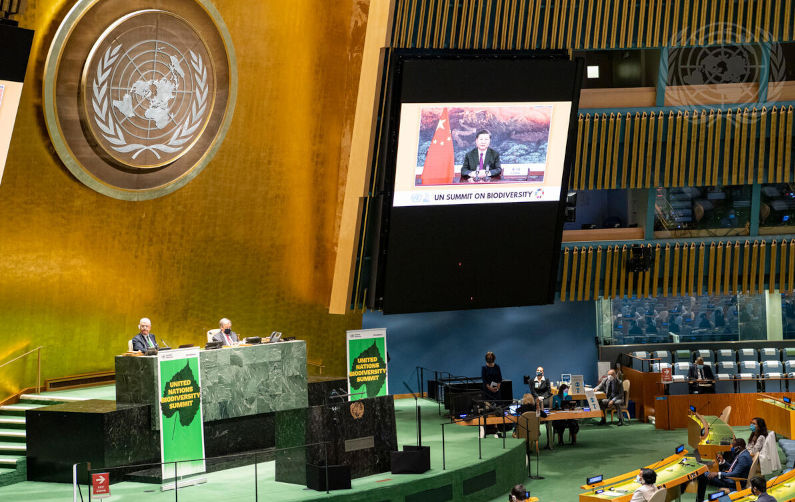China is likely to surpass its new emissions target. Australia should emulate its energy plan
October 2, 2025
In an address to the UN General Assembly last week, Chinese President Xi Jinping announced China’s target to reduce carbon emissions by 7-10% from their peak by 2035, with the goal of achieving even higher levels.
This sends a clear signal to the international community about China’s sustained commitment to addressing climate change in line with the Paris Agreement.
While the absolute reduction figure seems modest, China has a record of under-promising and over-delivering. For example, it surpassed its 2030 wind and solar power generation capacity target in July 2024, six years ahead of schedule. Over the last decade, it has systematically and rapidly implemented a transformative national plan of economy-wide decarbonisation through building the largest and fastest growing renewable energy system in the world while increasing its electrification rate at 10 percentage points per decade.
In the first eight months of 2025, newly added hydro, wind and solar power generation installations accounted for 86% of its total power additions, rapidly accelerating the transformation of China’s energy system into one that is mainly composed of renewable and non-fossil fuel energy sources. Coal continues to transition from its role of main power supply to flexible back-up. China’s solar installs in the first half of 2025 are double the rest of the world’s combined installs.
CEF expects to see more comprehensive targets and implementation directions for decarbonisation across economic and industrial sectors provided in China’s 15th Five-Year Plan for National Economic and Social Development, to be released soon.
Our detailed tracking of China’s decarbonisation trajectory shows that it continues to exceed expectations, cementing its leadership in clean energy deployment, manufacturing and electrification. On this basis, we project that China is likely to surpass its 2035 emissions target.
Climate change knows no borders, and while China is the world’s biggest polluter, accounting for 30% of emissions, it will take a global effort to address this existential challenge. On this point, China’s exports and investments into cleantech manufacturing and clean energy infrastructure over recent years are enabling both developed and developing economies to cut emissions and bolster energy security. China has been at the forefront in providing the capital, technology, infrastructure and training for nations as diverse as Brazil, Hungary, Thailand, Indonesia and Spain to accelerate their energy transitions, committing over US$170 billion in overseas foreign direct investment into clean tech since 2023.
While its emissions reduction target for 2035 is undeniably on the conservative side, we note the conditions of possibility for greater cuts are in place. The US is abrogating global leadership entirely in 2025, meaning there is an elevated geopolitical pressure on China to build on its astonishing decarbonisation momentum and engage with other global leaders like the EU. On China’s sustained record of exceeding its formal targets, we note that China’s national emissions likely peaked last year, six years ahead of its Paris Agreement commitment of 2030.
CEF expects a plateauing of emissions and then progressive reduction, and would think China could well deliver on Xi’s new commitment five years ahead of the formal 2035 target.
China leads the world in almost all zero-emissions industries of the future, from wind and solar, to batteries and electric vehicles, annually investing more than double that of the US or EU.
The unique characteristic of China’s approach, which distinguishes it from many other nations, is to lead by doing rather than by talking about what it might do, and the evidence of its bona fides is apparent in its astonishing scale of investments into and deployment of the technology that is key to solving the climate crisis. This is something Western nations, including Australia, should emulate.
Also this month, the Albanese Government released its new 2035 emissions reduction target of 62%-70% on 2005 levels by 2035. Clearly the government has gone more for practical deliverability than ambition, with a target at the lower end of the 65-75% range recommended by the Climate Change Authority. However, this does require more than doubling our current annual emissions reduction rate to 3.4%-4.2% over the coming decade. An accelerated transition will require significantly more upfront capital investment, much of which must be led by the government to catalyse an influx of private capital in the absence of a credible carbon price – a much-needed policy lever which is indispensable to driving transition investment.
We estimate that since the start of 2023, $70-75 billion of federal government funding and capital allocations have been made towards decarbonisation, electrification and the associated Future Made in Australia program, with another $6 billion of state allocations. A top priority should be getting these funds “off the table” and out the door in this term of government. We have tracked more than $16 billion of new deployments since December 2024, a significant step up in pace, but this needs to be built on to deliver on the new climate target, with more funding added.
Energy Minister Chris Bowen’s $3.5 billion national Cheaper Home Battery Rebate, which has resulted in the installation of more than 60,000 home batteries to date, shows the speed and scale that can be delivered with the right enabling policies and investment – i.e., with a commitment to leading by doing.
With its May 2025 supermajority mandate, the Albanese Government should now embrace “China Speed, China Scale” thinking — fast-tracking approvals, mobilising capital and seizing opportunities in zero-emissions industries in partnership with key trade allies, including China, our top trading partner — establishing our own credentials as a clean energy power as the latter goes all-in on claiming the crown as the world’s “decarbonisation nation”.
The views expressed in this article may or may not reflect those of Pearls and Irritations.
